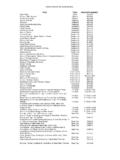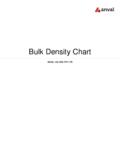Transcription of A C T I V ATED CARBON ADSORPTION FOR …
1 One of the major issues that must firstbe addressed when evaluating a specifice n v i ronmental VOC problem is whatt reatment technology to consider. For agiven situation there are likely a num-ber of treatment alternatives thatappear to have some first step in this evaluation is toe ffectively characterize the will need to know at least the fol-lowing inform a t i o n :Flow Rate- Continuos vs intermittent Contaminants Pre s e n t individual contaminants, concentration and v a r i a b i l i t yTe m p e r a t u re- Average and maximumF a l a m i b i l i t y- Upper and lower explosive limitsOnce you have characterized yourp roblem, each technology can be con-s i d e red for its ability to deal with theconditions identified. As an example,Table Ilists some of the more commontechnologies used to control industrialvapor phase pollutants, and the condi-tions under which they might be mostfavorably applied.
2 I can t stress enoughthe importance of this re v i e w, as this isw h e re most technical solutions fail. Ifyou solve the wrong problem or pick atechnical solution that does not re s p o n dto all the variables of your application,poor perf o rmance will likely re s u l t .A C T I VATED CARBON ADSORPTIONFOR TREATMENT OF VOC EMISSIONS Presented at the 13th Annual EnviroExpo,Boston Massachusetts May 2001 AustinShepherd, , President,Technical Director, CARBTROL Corporatione-mail: review of the characteristicsof activated CARBON and itsapplicability to emission control of VOC s. Design andcosts of CARBON systems arealso P P L I C ATION CONSIDERAT I O N SThe principal use of vapor phase acti-vated CARBON in the environmental fieldis for the removal of volatile org a n i ccompounds such as hydrocarbons, sol-vents, toxic gases and organic basedodors. In addition, chemically impre g-nated activated carbons can be used toc o n t rol certain inorganic pollutants suchas hydrogen sulfide, merc u ry, or properly applied, the adsorp-tion process will remove pollutants forwhich it is designed, to virtually non-detectable levels.
3 In fact one of the firstl a rge- scale uses of activated carbonwas in military gas masks where com-plete contaminant removal is ADSORPTION is equally eff e c t i v eon single component emissions as wellas complex mixtures of the industrial area, the most com-mon applications of activated carbona re for process off-gases, tank ventemissions, work area air purification,and odor control, either within theplant or related to plant d d i t i o n a l l y, activated CARBON is used inthe hazardous waste remediation are ato treat off-gases from air strippers andf rom soil vapor extraction re m e d i a t i o np ro j e c t s .EVALUATION OF ALTERNATIVE TREATMENTPROCESSESTABLEIACTIVATED CARBON THERMALOXIDATION SCRUBBERS PARTICULATE FILTERS CATALYTIC OXIDATION In the ADSORPTION process, moleculesof a contaminated gas are attracted toand accumulate on the surface of theactivated CARBON .
4 CARBON is a common-ly used adsorbent due to its very larg es u rface area. It can be made from avariety of base materials including coal,wood and coconut shells, and is manu-f a c t u red or activated in a high tempera-t u re controlled oxidation process. Apound of highly activated CARBON has as u rface area approaching 140 acre s .Compounds having a molecular weightover 50 and a boiling point greater than 50 degrees centigrade are goodcandidates for ADSORPTION . TABLE IIp resents a re p resentative list of org a n i ccompounds and their relative adsorp-tion strength. Organic contaminants areoften classified as weakly, moderately,or strongly adsorbed. You will note thata compound such as nitrobenzene hav-ing a molecular weight of 123 and aboiling point of 211 C is characterizedas a very strong adsorber. On the otherhand a compound such as methanewhich has a molecular weight of 16 anda boiling point of 161 C is a veryweakly adsorbed compound.
5 In fact, atthis capacity, for all practical purposes,methane removal with activated carbonwould not be cost eff e c t i v e .Physical ADSORPTION is dependant on thecharacteristics of the contaminant to beadsorbed, the temperature of the gass t ream to be processed, and the concen-tration of the contaminant in the gass t ream. The ADSORPTION capacity for ap a rticular contaminant re p resents theamount of the contaminant that can beadsorbed on a unit weight of activatedcarbon consumed at the conditions pre-sent in the application. Typical adsorp-tion capacities for moderately adsorbedcompounds range from 5 to 30 perc e n tof the weight of the CARBON ADSORPTION for Treatment of VOCE missionsHOW IT WORKSLIST OF ORGANIC COMPOUNDSCROSS SECTION OF CARBONA B S O R P T I O NC A PA C I T YThis F i g u re Ip resents an art i s t s re n d i-tion of the cross section of an activatedcarbon particle. Note that almost all ofthe surface area available for adsorptionis associated with its internal pore stru c-t u re.
6 Also note the relative change inp o re diameters, going from very large atthe granule surface boundary, to muchsmaller within the particle of the large and small porevolumes during the activation process iswhat makes individual activated carbonsp e rf o rm diff e re n t l y. Molecules of a cont-aminant tend to adsorb most strongly ina reas where the pore diameter of theadsorbent is close to the moleculardiameter of the most organic compounds willadsorb on activated CARBON to somed e g ree, the ADSORPTION process is moste ffective on higher molecular weight andhigh boiling point ITABLEIIRELATIVEADSORBTIONRATENITROBENZE NE123211 C51 TETRACHLOROETHANE166147 C40 TETRACHLOROETHYLENE165121 C35 STYRENE104145 C25 XYLENE106138 C21 NAPATHYLENE128217 C20 TOLUNE92111 C20 BENZENE7880 C12 MTBE8855 C12 HEXANE8668 C7 ETHLYACRILATE10057 C5 DIDHLOROETHANE9999 C7 METHYLETHYLKETONE7280 C4 METHYLENE CHLORIDE8440 C2 ACRILONITRILE5374 C2 ACETONE5856 14 FLOROMETHANE149neg 58 161 WEIGHTBOILING POINTCARBONCAPACITY%FIGURE IIIThe ADSORPTION isotherm plot shows theinfluence of concentration on adsorptionc a p a c i t y.
7 F i g u re IIp resents an adsorp-tion isotherm used to predict adsorptioncapacity for trichloroethylene. Note howthe ADSORPTION capacity varies from 20 to 65 percent over the concentrationrange of 10 to 10000 ppm in the gass t re a m .A series of isotherms at differing tem-p e r a t u res shows the influence of temper-a t u re on ADSORPTION capacity. In FigureIII you can see the effect of temperatureon the same trichloroethylene com-pound. At 100ppm the capacity of acti-vated CARBON for trichloroethylene variesf rom 17 to 40 percent as the temperaturechanges from 140 to 32 degrees F. F o rt u n a t e l y, most CARBON suppliershave developed isotherms for a range ofe n v i ronmental contaminants. AtC a r b t rol we have built a computerizeddatabase of ADSORPTION isotherms sothat we can easily model most enviro n-mental applications. By supplying to usthe gas flow rate, the contaminant con-centration and the temperature of thegas stream, a CARBON usage pre d i c t i o ncan be made.
8 activated CARBON ADSORPTION for Treatment of VOCE missions 3 TRICHLOROETHYLENE ISOTHERMFIGURE IID E S I G NC O N S I D E R AT I O N SActivated carbons used in the air pollution control field are normally supplied in a granular form with aparticle size ranging from 1 to 5 mil-limeters. In the granular form activat-ed CARBON can easily be packed into acontainment device through which acontaminated gas stream can beprocessed for i g u re IV shows the cross section of atypical fixed bed vapor phase ADSORPTION system in its simplestf o rm is made of a containment device( d rum or vessel), distribution and col-lection devices to effect proper circ u l a-tion of the gas stream through the acti-vated CARBON bed, and a means formoving the gas stream through the bed(such as a fan, a blower, or pre s s u r i z e dgas displacement). Packed activatedcarbon beds can be conveniently config-FIGURE IVCARBTROLG-4 ADSORBERO utletActivatedCarbon BedDistributorInletDrain VAPOR PHASE - ppmvTRICHLOROETHYLENE 32 FTRICHLOROETHYLENE140 FCARBTROL PHASE - ppmvtrichloroethyleneCARBTROL VAPORPHASEISOTHERMVAPORPHASEISOTHERMu red into small transportable drums ortanks, or into large fixed contactingdevices depending on the sizing for a particular appli-cation is governed primarily by beds u rface loading rate.
9 With a standard4-foot CARBON bed depth, a maximumgas-loading rate of 100 cfm per squarefoot of bed surface should be main-tained. This insures adequate gas con-tact and sufficient time to re a c hadsorption equilibrium. Higher gasflows are handled by increasing thecarbon bed surface (larger adsorbers)or adding multiple beds in of the chief advantages of granu-lar activated CARBON ADSORPTION is itssimplicity of application, Pre - e n g i-n e e red fixed bed adsorbers can be pur-chased and installed on most existingexhaust systems with a minimum ofcapital expenditure. Tr a n s p o rt a b l eadsorbers from 100 to 5000 pounds a re readily available as standard supplyf rom several manufactures. Air flowsfor these stock units go up to as muchas 5000 CFM. Larger systems up to20,000 CFM or higher are available ona custom basis. Once installed thesesystems operate for the most part unat-tended until the CARBON becomes spentand re q u i res replacement.
10 The fre q u e n-cy of replacement will vary for eachapplication but may range from weeklyto significant advantage of anadsorption process is that it pro v i d e son line re s e rve capacity on a passivebasis. The system is, in effect, availableon a continuos basis to handle vary i n gloads but only consumes CARBON whencontaminants are present in the exhausts t ream. Other processes may have sig-nificant fuel or chemical operating costseven when no contaminants are beingt re a t e d .Once the activated CARBON has becomespent it must be removed from serv i c eand replaced with fresh CARBON in ord e rto maintain the effectiveness of tre a t-ment. The spent CARBON can be dis-posed of and replaced with virgin car-bon, or the spent CARBON can bere t u rned to the supplier for re a c t i v a t i o nand reuse. Reactivation re s t o res most ofthe original CARBON ADSORPTION capacityand avoids expensive disposal CARBON ADSORPTION applicationsrely on offsite reactivation to supporttheir activated CARBON spent CARBON can be vacuumedf rom fixed ADSORPTION vessels andshipped to the reactivation center inbulk, or re t u rned to the re a c t i v a t i o nfacility in a transportable adsorber thats e rves both as an ADSORPTION vessel anda UN shipping system capital and operatingcosts can vary widely but depend pri-marily on the gas volume to be tre a t e dand the amount of CARBON consumed.





